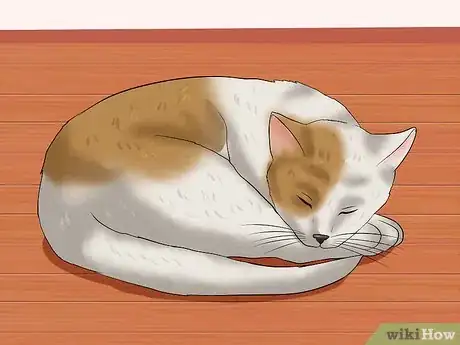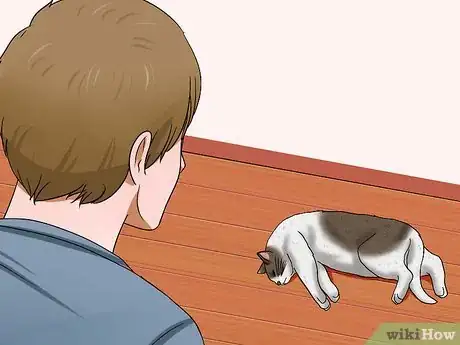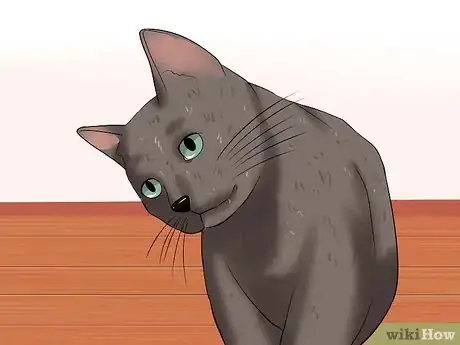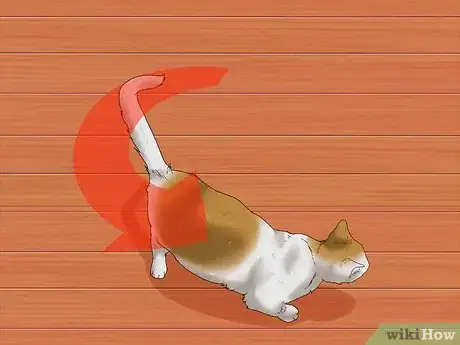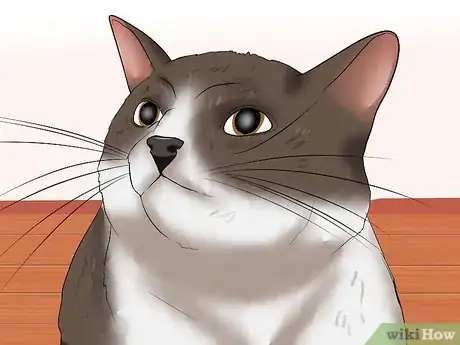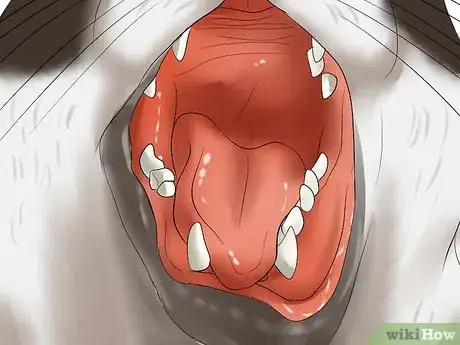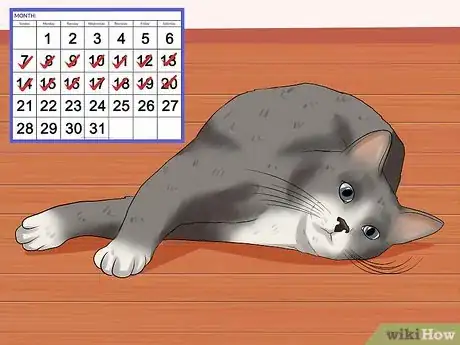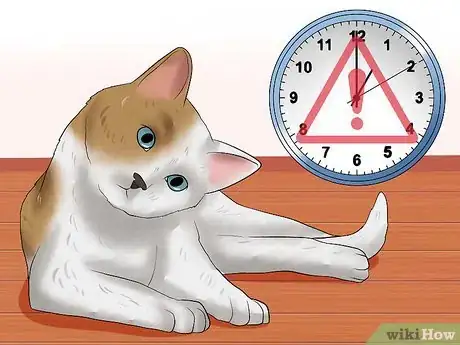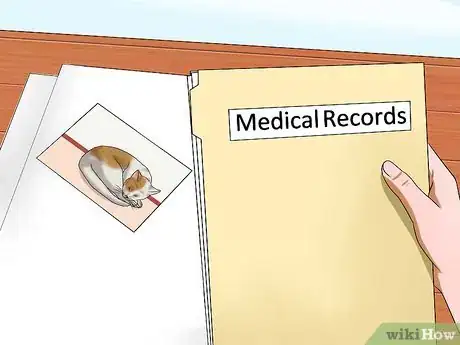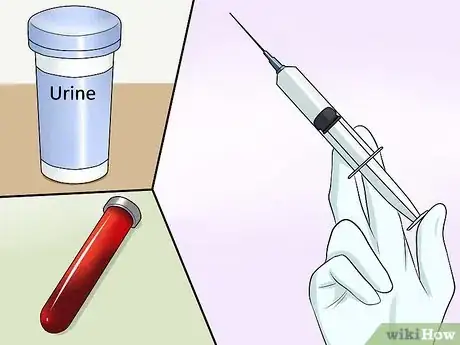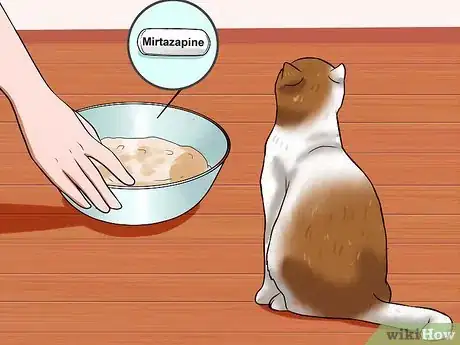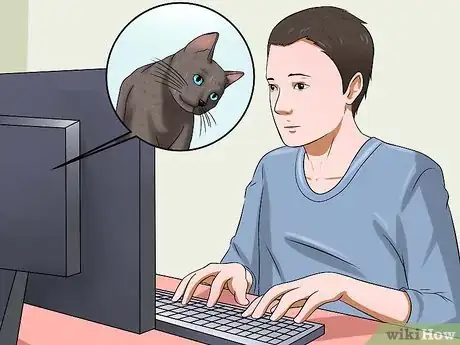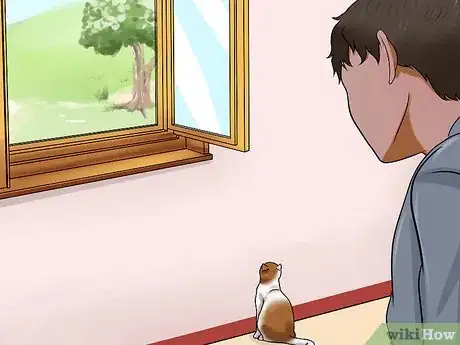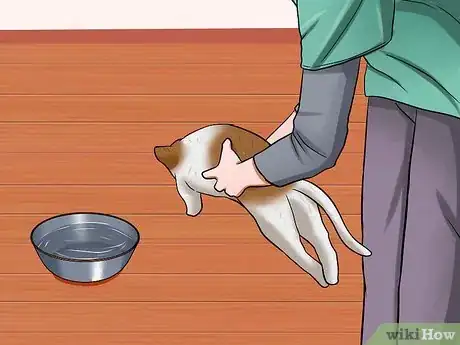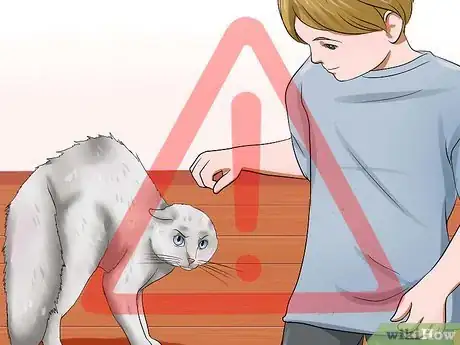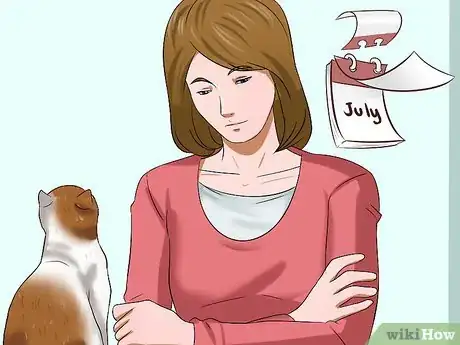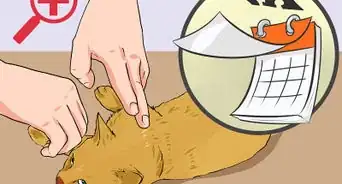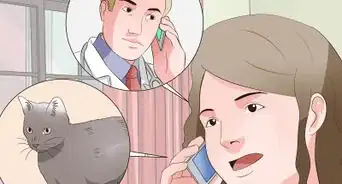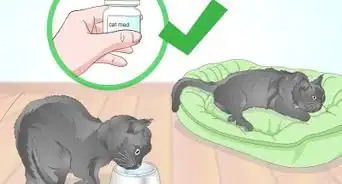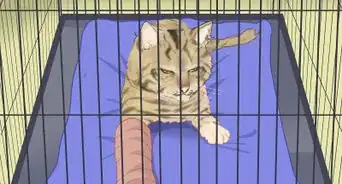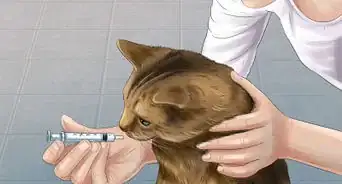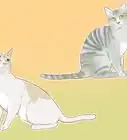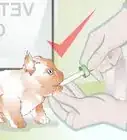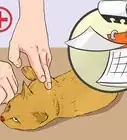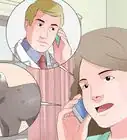This article was co-authored by Natalie Punt, DVM. Dr. Natalie Punt is a Veterinarian and the Founder and CEO of mPet- a smart phone app for pet owners to store, manage and transfer their pets medical records and health information. She specializes in small animal emergency and general medicine and veterinary practice economics. Dr. Punt holds a BS in Biochemistry and Molecular Biology from The University of California, Davis, an MS in Biochemistry from The University at Buffalo, and a DVM from Western University of Health Sciences.
There are 7 references cited in this article, which can be found at the bottom of the page.
wikiHow marks an article as reader-approved once it receives enough positive feedback. This article received 15 testimonials and 96% of readers who voted found it helpful, earning it our reader-approved status.
This article has been viewed 494,623 times.
Feline strokes, also known as vascular accidents, are caused by a lack of blood circulating to parts of the brain or a hemorrhage within the brain. Strokes and other abnormal neurological events cause certain functions to be lost, such as balance, equilibrium, control of limbs, sight, and consciousness. The immediate signs associated with a stroke may also indicate vestibular disease, seizures, or another condition. Regardless of the root cause, the symptoms associated with a stroke in a cat require an immediate trip to the veterinarian for proper care.[1] [2] [3]
Steps
Identifying Feline Stroke Symptoms
-
1Check the cat’s general alertness. If you notice that your cat is acting out of the ordinary, you need to examine the animal's general health. If the cat has lost consciousness, check the animal’s breathing. Check whether the cat responds to the sound of your voice. Note any shaking or spasms.[4]
-
2Watch for signs of depression. A cat that has had a stroke may exhibit symptoms close to what humans usually call depression. The cat may seem unusually quiet and stop responding in the usual ways.
- This behavior may occur because the cat may feel disoriented, woozy, nauseous, and/or suffer from a thumping headache.[5]
Advertisement -
3Look for an abnormal head tilt. You may notice that the cat holds its head at a strange angle with one ear lower than the other. He may exhibit this symptom as a tilting, turning, or twisting of the head. If due to a stroke, the symptom usually means pressure on a specific part of the brain.[6]
- This symptom may also signify another problem, such as vestibular disease, which leads to damage of the vestibular apparatus in the cat’s inner ear. Vestibular disease affects the cat’s sense of balance and orientation in a manner similar to signs of stroke. The symptom is cause for concern and an immediate trip to the veterinarian regardless whether a stroke or vestibular disease causes it.
-
4Watch for unstable walking or circling. You may notice that your cat cannot walk in a straight line. The cat might stagger as if drunk, fall to one side, or walk in circles. Again, when caused by a stroke, this symptom usually results from pressure on a portion of the brain.[7]
- These symptoms may also present as weakness on one side of the body or postural defects. The cat might measure steps wrong or show signs of weakness in all legs as well.[8]
- As with other symptoms due to pressure on the cat’s brain, unstable walking and/or circling can also be signs of vestibular disease.
- If your cat has tremors or moves its limbs wildly and rhythmically, this likely means a seizure. In some cases, you may not see the actual seizures. You may come across the disoriented cat afterward. This is called a post octal phase of a seizure and may last for a few minutes to a few hours.[9] Though an isolated seizure is less cause for immediate concern, you should still take the cat to the veterinarian as soon as possible.
-
5Examine the cat’s eyes.[10] Look closely at your cat's eyes. If he has had a stroke, his pupils may be different-sized or his eyes may flick from side to side. This is called nystagmus and it is due to a lack of blood supply to the nerves that feed the eyes.[11] [12]
- If your cat's pupils are unequal in size, the third eyelids are prominent, and if there is a head tilt, then this is more indicative of vestibular disease than a stroke.
- As a side effect of the nystagmus, the cat may be nauseous from motion sickness.
-
6Check your cat for blindness. Though less common than the other symptoms related to the cat’s eyes, some cats may also exhibit blindness due to stroke.[13] Even in cases where the blindness isn’t from a stroke, the symptom is a telltale sign of high blood pressure in a cat, which often precedes a stroke.[14]
-
7Check the cat’s tongue. It should be pink.[15] If the tongue is blue, purple, or white, that is serious. Your cat needs to be taken to the veterinary hospital immediately.
-
8Do not look too hard for symptoms seen in strokes in humans. The most classic signs of stroke in humans include partial paralysis and a droop to one side of the face. Cats do not experience strokes the same way humans do. These symptoms tend not to present themselves when a cat has a stroke.[16]
-
9Note how quickly the symptoms exhibited themselves. Since the loss of blood supply to the part of the brain happens quickly, the effects of a stroke happen suddenly as well. If your cat develops worsening balance issues over several weeks, for instance, then a stroke is not the likely cause. However, you should still take your cat to the veterinarian for any recurring or worsening symptoms.
-
10Track how long the symptoms last. Stroke symptoms usually last at least twenty-four hours in a cat. You should take your cat to the veterinarian as soon as you observe symptoms, but that might not always be possible. Like humans, cats can have a mini-stroke or transient ischemic attack (TIA). This means that the symptoms may begin to subside after a day; however, you should still take your cat to the veterinarian even if symptoms decrease in severity.
- These temporary signs are a strong indication that there is a problem requiring further medical investigation to prevent the cat from having a full-blown stroke in the near future.
-
11Examine your cat’s medical history. Though not an immediate, observable sign, strokes are more likely in cats when they have underlying health conditions.[17] If you regularly take your cat to the veterinarian, look at your cat’s records. If the veterinarian has previously diagnosed your cat with kidney disease, heart disease, high blood pressure, or overactive thyroid glands, then the chance of a stroke is much higher.
Caring for a Cat That Has Suffered a Stroke
-
1Take the cat to the veterinarian immediately. The sooner the cat sees a veterinarian, the better care the animal will receive, meaning a better chance for recovery. Strokes in cats are not always as devastating to the animal as strokes tend to be in humans; however, the event is still serious and requires immediate attention.
- You may want to call ahead as you place the cat in its carrier to tell the veterinarian the symptoms you’ve seen as well.
- If it is at night, you may need to take him to the emergency veterinary hospital.
-
2Cooperate with the veterinarian. Your vet will ask you some questions to help determine a course of action. They will ask questions about many things involving your cat's behavior, so make sure you pay close attention to your cat. They will ask if your cat could have ingested anything like a plant, a medication, or a poison to cause the symptoms. They might also ask if there was any known trauma like a fall prior to the symptoms. They will ask about any changes in his water or food intake. They will also likely ask if there has been any vomiting, diarrhea, or general lethargy.
- You will need to know if your cat has had his rabies vaccination recently as well.
-
3Get tests. Your veterinarian may order a blood panel, urinalysis, x-rays, or an ultrasound. These tests can help determining stroke or the underlying conditions that often accompany a stroke in cats (discussed in Part 1). If your vet thinks there might be a serious neurological problem, a veterinarian specializing in neurology may be needed for a consult. The specialist may ask for additional tests, such as an MRI or CT scan, which can identify a blood clot or area of damage to the brain.
- These test are done for animals in a similar way to how they are done for humans.
-
4Care for your cat. In many cases, your cat’s symptoms may resolve after a few days of TLC at home. In some cases, the cat may require hospitalization with the veterinarian. Neurological outcomes can be very difficult to determine. You and your veterinarian will need time to tell exactly what the long lasting effects or conditions might be.
- If your cat has motion sickness as a symptom, a medication such as Cerenia is available to manage that.
- If your cat’s appetite is down, there may be options that increase the appetite such as Mirtazapine.
- If your cat is having seizures, your veterinarian will likely discuss medical management with anti-seizure medications such as phenobarbital.[18]
-
5Research possible outcomes. If the symptoms were actually vestibular disease, the cat may spontaneously recover in a few days. In other situations, the cat may have a sustained head tilt. That may be the only lasting effect while he is otherwise fine. Other cats may continue to have some balance problems. Since the brain is complicated, the full outcome of a neurological event cannot be completely predicted.
- It may be tough to watch your pet stumble around. Don't worry because they are likely not in pain.[19]
-
6Protect your cat. Any cat that has had neurological problems should be kept indoors for its safety. You may need to confine the cat to one room for a while after the cat comes home. This is for the cat’s safety, especially if you have other pets in the household that may attack the cat for behaving abnormally.
-
7Help the cat with eating and other functions if necessary. While recovering, you may need to help the cat eat, drink, or go to the litter box. This will depend on the severity of the condition. You may need to pick them up and carry him to the food bowl, to the water dish, or to the litter box. Watch for signs that he is hungry or needs to go to the litter box, such as meowing or general discontent.
- It will take time to know if this will be a temporary or a permanent necessity for your cat.
-
8Take caution with children around the cat. While monitoring the cat and noting symptoms, be careful with any children around the cat. If your cat is confused, disoriented, or seizing, then the cat may bite or scratch unintentionally. Keeping children away is the best way to avoid potential injury.
-
9Stay patient. With proper nursing and care, some cats recover very well. Even in these situations, the recovery can take anywhere from 2-4 months. Stay patient with the process and remember how much your cat needs you while recovering.
Expert Q&A
-
QuestionWhat happens after a cat has a stroke?
 Natalie Punt, DVMDr. Natalie Punt is a Veterinarian and the Founder and CEO of mPet- a smart phone app for pet owners to store, manage and transfer their pets medical records and health information. She specializes in small animal emergency and general medicine and veterinary practice economics. Dr. Punt holds a BS in Biochemistry and Molecular Biology from The University of California, Davis, an MS in Biochemistry from The University at Buffalo, and a DVM from Western University of Health Sciences.
Natalie Punt, DVMDr. Natalie Punt is a Veterinarian and the Founder and CEO of mPet- a smart phone app for pet owners to store, manage and transfer their pets medical records and health information. She specializes in small animal emergency and general medicine and veterinary practice economics. Dr. Punt holds a BS in Biochemistry and Molecular Biology from The University of California, Davis, an MS in Biochemistry from The University at Buffalo, and a DVM from Western University of Health Sciences.
Veterinarian Your cat may develop changes to their facial expression, like droopy eyes or sagging. They may also meow a bit differently.
Your cat may develop changes to their facial expression, like droopy eyes or sagging. They may also meow a bit differently. -
QuestionHow do cats act when they have a stroke?
 Natalie Punt, DVMDr. Natalie Punt is a Veterinarian and the Founder and CEO of mPet- a smart phone app for pet owners to store, manage and transfer their pets medical records and health information. She specializes in small animal emergency and general medicine and veterinary practice economics. Dr. Punt holds a BS in Biochemistry and Molecular Biology from The University of California, Davis, an MS in Biochemistry from The University at Buffalo, and a DVM from Western University of Health Sciences.
Natalie Punt, DVMDr. Natalie Punt is a Veterinarian and the Founder and CEO of mPet- a smart phone app for pet owners to store, manage and transfer their pets medical records and health information. She specializes in small animal emergency and general medicine and veterinary practice economics. Dr. Punt holds a BS in Biochemistry and Molecular Biology from The University of California, Davis, an MS in Biochemistry from The University at Buffalo, and a DVM from Western University of Health Sciences.
Veterinarian Your cat may be a bit more active at night than they were before. Cats sleep for a good portion of the day, so extra nighttime activity could be a warning sign.
Your cat may be a bit more active at night than they were before. Cats sleep for a good portion of the day, so extra nighttime activity could be a warning sign. -
QuestionMy cat's head is tilted and he can't stand up. Did he have a stroke?
 Pippa Elliott, MRCVSDr. Elliott, BVMS, MRCVS is a veterinarian with over 30 years of experience in veterinary surgery and companion animal practice. She graduated from the University of Glasgow in 1987 with a degree in veterinary medicine and surgery. She has worked at the same animal clinic in her hometown for over 20 years.
Pippa Elliott, MRCVSDr. Elliott, BVMS, MRCVS is a veterinarian with over 30 years of experience in veterinary surgery and companion animal practice. She graduated from the University of Glasgow in 1987 with a degree in veterinary medicine and surgery. She has worked at the same animal clinic in her hometown for over 20 years.
Veterinarian This might be a stroke or it could be a different condition called vestibular syndrome. This is a problem with the balance mechanism in the inner ear and leads to the symptoms you describe. A vet needs to check the cat's ears for signs of infection and start appropriate treatment. Cats with vestibular syndrome usually do well although some are left with a permanent head tilt.
This might be a stroke or it could be a different condition called vestibular syndrome. This is a problem with the balance mechanism in the inner ear and leads to the symptoms you describe. A vet needs to check the cat's ears for signs of infection and start appropriate treatment. Cats with vestibular syndrome usually do well although some are left with a permanent head tilt.
References
- ↑ Garosi, Laurent S. "Cerebrovascular Disease in Dogs and Cats," Veterinary Clinics of North America: Small Animal Practice. 40:1 (January 2010), 65-79
- ↑ http://www.veterinarypartner.com/Content.plx?P=A&S=0&C=0&A=564
- ↑ http://www.veterinarypartner.com/Content.plx?P=A&S=0&C=0&A=2354
- ↑ http://www.peteducation.com/article.cfm?c=1+2144&aid=2896
- ↑ Clinical Medicine in the Dog and Cat. Schaer. Publisher: Manson.
- ↑ Clinical Medicine in the Dog and Cat. Schaer. Publisher: Manson.
- ↑ Clinical Medicine in the Dog and Cat. Schaer. Publisher: Manson.
- ↑ http://www.veterinarypartner.com/Content.plx?P=A&S=0&C=0&A=2354
- ↑ http://www.veterinarypartner.com/Content.plx?P=A&S=0&C=0&A=560
- ↑ Natalie Punt, DVM. Veterinarian. Expert Interview. 19 August 2021.
- ↑ Clinical Medicine in the Dog and Cat. Schaer. Publisher: Manson.
- ↑ http://www.veterinarypartner.com/Content.plx?P=A&S=0&C=0&A=564
- ↑ Clinical Medicine in the Dog and Cat. Schaer. Publisher: Manson.
- ↑ Clinical Medicine in the Dog and Cat. Schaer. Publisher: Manson.
- ↑ http://www.peteducation.com/article.cfm?c=1+2144&aid=2896
- ↑ Clinical Medicine in the Dog and Cat. Schaer. Publisher: Manson.
- ↑ Clinical Medicine in the Dog and Cat. Schaer. Publisher: Manson.
- ↑ http://www.veterinarypartner.com/Content.plx?P=A&S=0&C=0&A=560
- ↑ http://www.veterinarypartner.com/Content.plx?P=A&S=0&C=0&A=564
About This Article
If you suspect that your cat may have had a stroke, listen for their breathing and observe the cat to see if they respond to your voice or seem to be shaking or spasming. Then, look at your cat to see if its head is tilting to one side, which can be a sign of pressure in the brain due to a stroke. If your cat is unstable when the walk or is pacing in circles, look for other symptoms of a stroke before visiting the vet. Finally, take a look at your cat's tongue, and if it's blue, purple, or white, take the cat to an emergency vet immediately for medical attention. For helpful advice on caring for a cat that has had a stroke, keep reading.
